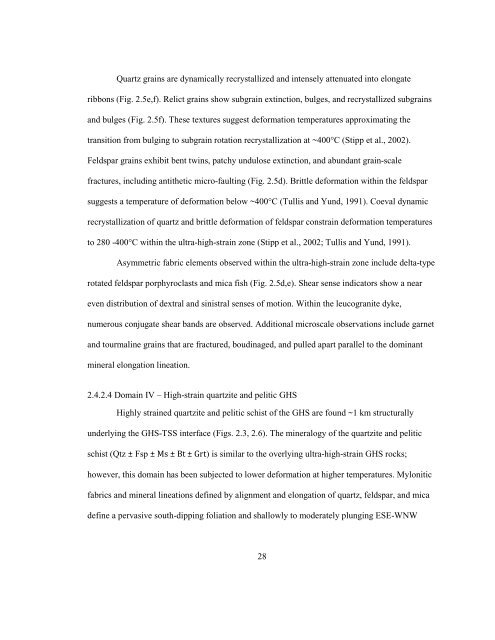title of the thesis - Department of Geology - Queen's University
title of the thesis - Department of Geology - Queen's University
title of the thesis - Department of Geology - Queen's University
Create successful ePaper yourself
Turn your PDF publications into a flip-book with our unique Google optimized e-Paper software.
Quartz grains are dynamically recrystallized and intensely attenuated into elongate<br />
ribbons (Fig. 2.5e,f). Relict grains show subgrain extinction, bulges, and recrystallized subgrains<br />
and bulges (Fig. 2.5f). These textures suggest deformation temperatures approximating <strong>the</strong><br />
transition from bulging to subgrain rotation recrystallization at ~400°C (Stipp et al., 2002).<br />
Feldspar grains exhibit bent twins, patchy undulose extinction, and abundant grain-scale<br />
fractures, including anti<strong>the</strong>tic micro-faulting (Fig. 2.5d). Brittle deformation within <strong>the</strong> feldspar<br />
suggests a temperature <strong>of</strong> deformation below ~400°C (Tullis and Yund, 1991). Coeval dynamic<br />
recrystallization <strong>of</strong> quartz and brittle deformation <strong>of</strong> feldspar constrain deformation temperatures<br />
to 280 -400°C within <strong>the</strong> ultra-high-strain zone (Stipp et al., 2002; Tullis and Yund, 1991).<br />
Asymmetric fabric elements observed within <strong>the</strong> ultra-high-strain zone include delta-type<br />
rotated feldspar porphyroclasts and mica fish (Fig. 2.5d,e). Shear sense indicators show a near<br />
even distribution <strong>of</strong> dextral and sinistral senses <strong>of</strong> motion. Within <strong>the</strong> leucogranite dyke,<br />
numerous conjugate shear bands are observed. Additional microscale observations include garnet<br />
and tourmaline grains that are fractured, boudinaged, and pulled apart parallel to <strong>the</strong> dominant<br />
mineral elongation lineation.<br />
2.4.2.4 Domain IV – High-strain quartzite and pelitic GHS<br />
Highly strained quartzite and pelitic schist <strong>of</strong> <strong>the</strong> GHS are found ~1 km structurally<br />
underlying <strong>the</strong> GHS-TSS interface (Figs. 2.3, 2.6). The mineralogy <strong>of</strong> <strong>the</strong> quartzite and pelitic<br />
schist (Qtz ± Fsp ± Ms ± Bt ± Grt) is similar to <strong>the</strong> overlying ultra-high-strain GHS rocks;<br />
however, this domain has been subjected to lower deformation at higher temperatures. Mylonitic<br />
fabrics and mineral lineations defined by alignment and elongation <strong>of</strong> quartz, feldspar, and mica<br />
define a pervasive south-dipping foliation and shallowly to moderately plunging ESE-WNW<br />
28

















